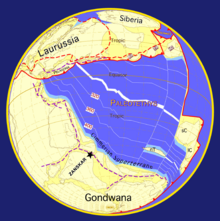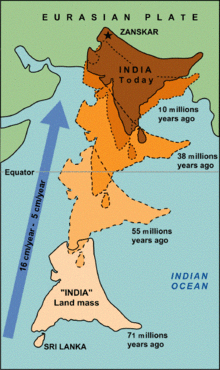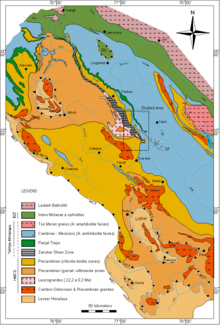Geology of the Himalayas
This article needs additional citations for verification. (March 2024) |






The geology of the Himalayas is a record of the most dramatic and visible creations of the immense
From south to north the Himalaya (Himalaya orogen) is divided into 4 parallel
From east to west the Himalayas are divided into 3 regions,
Making of the Himalayas
During Late
In the Early
In the Norian (210 Ma), a major rifting episode split Gondwana in two parts. The Indian continent became part of East Gondwana, together with Australia and Antarctica. However, the separation of East and West Gondwana, together with the formation of oceanic crust, occurred later, in the Callovian (160-155 Ma). The Indian plate then broke off from Australia and Antarctica in the Early Cretaceous (130-125 Ma) with the opening of the "South Indian Ocean" (Fig. 3).
In the Late
While most of the oceanic crust was "simply" subducted below the Tibetan block during the northward motion of India, at least three major mechanisms have been put forward, either separately or jointly, to explain what happened, since collision, to the 2500 km of "missing continental crust".
- The first mechanism also calls upon the subduction of the Indian continental crust below Tibet.
- Second is the extrusion or escape tectonics mechanism (Indochinablock out of its way.
- The third proposed mechanism is that a large part (~1000 km ( together with the deformation of the Tibetan crust.
Even though it is more than reasonable to argue that this huge amount of crustal shortening most probably results from a combination of these three mechanisms, it is nevertheless the last mechanism which created the high topographic relief of the Himalaya.
The Himalayan tectonics result in long term deformation. This includes shortening across the Himalayas that range from 900 to 1,500 km. Said shortening is a product of the significant ongoing seismic activity. The continued convergence of the Indian plate with the Eurasian plate results in mega earthquakes. These seismic events can reach greater than MW 8 and result in intense damage to infrastructure. The mid-crustal ramp in the Himalayas is a key geologic feature in the history for both long-term and short-term seismic processes linked to deformation and shortening. Over the last 15 Ma, the ramp has gradually moved south due to duplexing, accretion, and tectonic undercutting.[16]
The ongoing active collision of the Indian and Eurasian continental plates challenges one hypothesis for plate motion which relies on subduction.
Major tectonic subdivisions of the Himalaya
One of the most striking aspects of the Himalayan orogen is the lateral continuity of its major tectonic elements. The Himalaya is classically divided into four
Sub-Himalayan (Churia Hills or Sivaliks) tectonic plate
The Sub-Himalayan tectonic plate is sometimes referred to as the Cis-Himalayan tectonic plate in the older literature. It forms the southern
Lesser Himalaya (LH) tectonic plate
The Lesser Himalaya (LH) tectonic plate is mainly formed by Upper
Central Himalayan Domain, (CHD) or High Himalaya tectonic plate
The Central Himalayan Domain forms the backbone of the Himalayan orogen and encompasses the areas with the highest topographic relief (highest peaks). It is commonly separated into four zones.
High Himalayan Crystalline Sequence (HHCS)
Approximately 30 different names exist in the literature to describe this unit; the most frequently found equivalents are "Greater Himalayan Sequence", "
Tethys Himalaya (TH)
The Tethys Himalaya is an approximately 100-km-wide
Nyimaling-Tso Morari Metamorphic Dome (NTMD)
"Nyimaling-Tso Morari Metamorphic Dome" in the Ladakh region, the "Tethys Himalaya synclinorium" passes gradually to the north in a large dome of greenschist to eclogitic metamorphic rocks. As with the HHCS, these metamorphic rocks represent the metamorphic equivalent of the sediments forming the base of the Tethys Himalaya. The "Precambrian Phe Formation" is also here intruded by several Ordovician (c. 480 Ma[19]) granites.
Lamayuru and Markha Units (LMU)
The Lamayuru and Markha Units are formed by
Exhumation of Metamorphic Rocks
The metamorphic rocks of the Himalaya can be very useful in deciphering and coming up with models of tectonic relationships. According to Kohn (2014), the exhumation of metamorphic rocks can be explained by the Main Himalayan Thrust. [20] Although the mechanism of emplacing higher grade metamorphic rocks on top of lower grade metamorphic rocks still strongly debated, Kohn believes that it is due to long periods of transportation of higher grade metamorphic rocks on the Main Himalayan Thrust. Essentially, the longer the higher grade rocks were spatially interacting with the thrust, the farther they were transported.
The exhumation of eclogite and granulite rocks can be explained by several different models. The first model includes slab tear where the lower plate tore off into the mantle leading to high amounts of rebound. The second model states that the rocks got to a certain point in subduction and then were forced back up through the channel they came down due to a space problem. The third model states that the thick continental crust of India further exasperated the space problem and caused the corner flow of those rocks back up the channel. The fourth model includes the rocks being transported along the Main Himalayan Thrust.
Indus Suture Zone (ISZ) (or Yarlung-Tsangpo Suture Zone) tectonic plate
ISZ, also called
- Ophiolite Mélanges, composed of an intercalation of flysch and ophiolites from the Neotethys oceanic crust.
- Dras Volcanics, relicts of a Late Cretaceous to Late Jurassic volcanic island arc and consist of basalts, dacites, volcanoclastites, pillow lavas and minor radiolarian cherts
- lacustrine sediments derived mainly from the Ladakh batholith but also from the suture zone itself and the Tethys Himalaya. These molasses are post-collisionaland thus Eocene to post-Eocene.
- active margin of Andean type. Widespread volcanism in this volcanic arc was caused by the melting of the mantle at the base of the Tibetan bloc, triggered by the dehydration of the subducting Indian oceanic crust.
Seismic Activity
The modern day rate of convergence between the Indian and Eurasian plates is measured to be approximately 17 mm/yr. [21]This convergence is accommodated through seismic activity in active fault zones. As a result, the Himalayan range is one of the most seismically active regions in the world. This region has experienced many high magnitude earthquakes in the last 100 years, including the 1905 Kangra Earthquake, 1975 Kinnaur Earthquake, 1991 Uttarkashi Earthquake, and the 1999 Chamoli Earthquake, all of which were recorded at magnitudes equal or greater than Mw 6.6.
A recent study (Parija et al, 2021) sought to quantify the Coulomb Stress Transfer in the Western Himalayas. Coulomb stress transfer is used to quantify how earthquakes release stress, identifying areas that are put under increased stress and those that have been unloaded. This study and those like it are important in understanding the current state of fault zones in the region, as well as their potential for rupture in the future. [21]
See also
Localized geology and geomorphology topics for various parts of the Himalaya are discussed on other pages:
- Geology of Nepal
- Zanskar is a subdistrict of the Kargil district, which lies in the eastern half of the Indian union territory of Ladakh.
- Indus River - the erosion at Nanga Parbat is causing rapid uplifting of lower crustal rocks
- Mount Everest
- Sutlej River - similar small scale erosion to the Indus
- Tibetan Plateau to the North (also discussed in Geography of Tibet)
- Paleotethys
- Karakoram fault system - major active fault system within the Himalaya
- Main Himalayan Thrust - the root thrust that underlies the Himalaya
Notes
- ^ A more modern paleogeographic reconstruction of the Early Permian can be found at "Paleotethys". Université de Lausanne. Archived from the original on 8 June 2011..
- ^ A more modern paleogeographic reconstruction of the Permian-Triassic boundary, see "Neotethys". Université de Lausanne. Archived from the original on 19 January 2011..
- ^ The fourfold division of Himalayan units has been used since the work of Blanford & Medlicott (1879) and Heim & Gansser (1939).
References
Citations
- ^ Stampfli 2000.
- ^ Stampfli et al. 2001.
- ^ Stampfli & Borel 2002.
- ^ Burbank et al. 1996.
- ^ DiPietro & Pogue 2004.
- ^ Dèzes 1999.
- ^ Ding, Kapp & Wan 2005.
- ^ Klootwijk et al. 1992.
- ^ Achache, Courtillot & Xiu 1984.
- ^ Patriat & Achache 1984.
- ^ Besse et al. 1984.
- ^ Besse & Courtillot 1988.
- ^ Klootwijk, Conaghan & Powell 1985.
- ^ Bingham & Klootwijk 1980.
- ^ Le Pichon, Fournier & Jolivet 1992.
- S2CID 232084060.
- ^ Frank, Gansser & Trommsdorff 1977.
- ^ Steck et al. 1993a.
- ^ Girard & Bussy 1998.
- .
- ^ ISSN 0278-7407.
Sources
- Achache, José; Courtillot, Vincent; Xiu, Zhou Yao (1984). "Paleogeographic and tectonic evolution of southern Tibet since Middle Cretaceous time: New paleomagnetic data and synthesis". Journal of Geophysical Research. 89 (B12): 10311–10340. .
- Besse, J.; Courtillot, V.; Pozzi, J.P.; Westphal, M.; Zhou, Y.X. (18 October 1984). "Palaeomagnetic estimates of crustal shortening in the Himalayan thrusts and Zangbo Suture". Nature. 311 (5987): 621–626. S2CID 4333485.
- Besse, Jean; Courtillot, Vincent (10 October 1988). "Paleogeographic maps of the continents bordering the Indian Ocean since the Early Jurassic". Journal of Geophysical Research. 93 (B10): 11791–11808. ISSN 0148-0227.
- Bingham, Douglas K.; Klootwijk, Chris T. (27 March 1980). "Palaeomagnetic constraints on Greater India's underthrusting of the Tibetan Plateau". Nature. 284 (5754): 336–338. S2CID 4279478.
- Blanford, W.T.; Medlicott, H.B. (1879). "A manual of the geology of India". Nature. 20 (504). Calcutta: 191. S2CID 45807101.
- Brookfield, M.E. (1993). "The Himalaya passive margin from Precambrian to Cretaceous times". Sedimentary Geology. 84 (1–4): 1–35. .
- Burbank, Douglas W.; Leland, John; Fielding, Eric; Anderson, Robert S.; Brozovic, Nicholas; Reid, Mary R.; Duncan, Christopher (8 February 1996). "Bedrock incision, rock uplift and threshold hillslopes in the northwestern Himalayas". Nature. 379 (6565): 505–510. S2CID 4362558.
- .
- Dewey, J.F.; Cande, S.; Pitman III, W.C. (1989). "Tectonic evolution of the Indian/Eurasia Collision Zone". Eclogae Geologicae Helvetiae. 82 (3): 717–734.
- Dèzes, Pierre (1999). Tectonic and metamorphic Evolution of the Central Himalayan Domain in Southeast Zanskar (Kashmir, India). Mémoires de Géologie (PhD thesis). Vol. 32. ISSN 1015-3578.
- Ding, Lin; Kapp, Paul; Wan, Xiaoqiao (6 May 2005). "Paleocene-Eocene record of ophiolite obduction and initial India-Asia collision, south central Tibet". Tectonics. 24 (3): TC3001. S2CID 39124270.
- DiPietro, Joseph A.; Pogue, Kevin R. (September 2004). "Tectonostratigraphic subdivisions of the Himalaya: A view from the west". S2CID 129138752.
- Le Fort, P.; Cronin, V. S. (1 September 1988). "Granites in the Tectonic Evolution of the Himalaya, Karakoram and Southern Tibet". Philosophical Transactions of the Royal Society of London. Series A, Mathematical and Physical Sciences. 326 (1589): 281–299. S2CID 202574726.
- Frank, W.; Gansser, A.; Trommsdorff, V. (1977). "Geological observations in the Ladakh area (Himalayas); a preliminary report". Schweizerische Mineralogische und Petrographische Mitteilungen Bulletin. 57 (1): 89–113.
- Girard, M.; Bussy, F. (1998). "Late Pan-African magmatism in Himalaya: new geochronological and geochemical data from the Ordovician Tso Morari metagranites (Ladakh, NW India)". Schweizerische Mineralogische und Petrographische Mitteilungen Bulletin. 79: 399–418.
- Heim, A.; Gansser, A. (1939). "Central Himalaya; geological observations of the Swiss expedition 1936". Schweizer. Naturf. Ges., Denksch. 73 (1): 245.
- Klootwijk, C.T.; Conaghan, P.J.; Powell, C.McA. (October 1985). "The Himalayan Arc: large-scale continental subduction, oroclinal bending and back-arc spreading". Earth and Planetary Science Letters. 75 (2–3): 167–183. .
- Klootwijk, Chris T.; Gee, Jeff S.; Peirce, John W.; Smith, Guy M.; McFadden, Phil L. (May 1992). "An early India-Asia contact: Paleomagnetic constraints from Ninetyeast Ridge, ODP Leg 121". Geology. 20 (5): 395–398. .
- Molnar, P.; Tapponnier, P. (1975). "Cenozoic tectonics of Asia; effects of a continental collision". Science. 189 (4201): 419–426. PMID 17781869.
- Patriat, Philippe; Achache, José (18 October 1984). "India-Eurasia collision chronology has implications for crustal shortening and driving mechanism of plates". Nature. 311 (5987): 615–621. S2CID 4315858.
- S2CID 36349751.
- Ricou, L.M. (1994). "Tethys reconstructed: plates, continental fragments and their Boundaries since 260 Ma from Central America to South-eastern Asia". Geodinamica Acta. 7 (4): 169–218. .
- Stampfli, G.M.; Mosar, J.; Favre, P.; Pillevuit, A.; Vannay, J.-C. (1998). "Permo-Triassic evolution of the western Tethyan realm: the Neotethys/east-Mediterranean basin connection". PeriThetys. 3.
- Stampfli, G.M. (2000). E. Bozkurt; J.A. Winchester; J.D.A. Piper (eds.). "Tectonics and magmatism in Turkey and surrounding area". Geological Society of London, Special Publications. 173: 1–23. S2CID 219202298.
- Stampfli, G.M.; Mosar, J.; Favre, P.; Pillevuit, A.; Vannay, J.-C. (2001). "Permo-Mesozoic evolution of the western Tethyan realm: the Neotethys/East- Mediterranean connection". In P.A. Ziegler; W. Cavazza; A.H.F. Robertson; S. Crasquin-Soleau (eds.). PeriTethys memoir 6: Peritethyan rift/wrench basins and passive margins. IGCP 369. Mém. Museum Nat. Hist. Nat. Vol. 186. pp. 51–108.
- Stampfli, G.M.; Borel, G.D. (28 February 2002). "A plate tectonic model for the Paleozoic and Mesozoic constrained by dynamic plate boundaries and restored synthetic oceanic isochrons". Earth and Planetary Science Letters. 196 (1): 17–33. .
- Stampfli, GM; Borel, GD (2004). "The TRANSMED Transects in Space and Time: Constraints on the Paleotectonic Evolution of the Mediterranean Domain". In Cavazza W; Roure F; Spakman W; Stampfli GM; Ziegler P (eds.). The TRANSMED Atlas: the Mediterranean Region from Crust to Mantle. Springer Verlag. ISBN 978-3-540-22181-4.
- Steck, A.; Spring, L.; Vannay, J.C.; Masson, H.; Stutz, E.; Bucher, H.; Marchant, R.; Tièche, J.C. (1993a). "Geological Transect Across the Northwestern Himalaya in eastern Ladakh and Lahul (A Model for the Continental Collision of India and Asia)" (PDF). Eclogae Geologicae Helvetiae. 86 (1): 219–263.
- Steck, A.; Spring, L.; Vannay, J.C.; Masson, H.; Bucher, H.; Stutz, E.; Marchant, R.; Tieche, J.C. (1993b). Treloar, P. J.; Searle, M. P. (eds.). "The tectonic evolution of the northwestern Himalaya in eastern Ladakh and Lahul, India, in Himalayan Tectonics". Geological Society, London, Special Publications. 74 (1): 265–276. S2CID 128420922.
- Yin, An (May 2006). "Cenozoic tectonic evolution of the Himalayan orogen as constrained by along-strike variation of structural geometry, exhumation history, and foreland sedimentation". Earth-Science Reviews. 76 (1–2): 1–131. ISSN 0012-8252.
External links
- Catlos, Elizabeth Jacqueline (2000). Geochronologic and Thermobarometric Constraints on the Evolution of the Main Central Thrust, Himalayan Orogen (PDF). PhD Thesis. University of California.
- "Geology and Petrographic study of the area from Chiraundi Khola to Thulo Khola, Dhading/Nawakot district, central Nepal". MS Thesis by Gyanendra Gurung
- Granitoids of the Himalayan Collisional Belt. Special Edition of "The Journal of the Virtual Explorer"
- Reconstruction of the evolution of the Alpine-Himalayan orogeny. Special Edition of "The Journal of the Virtual Explorer"
- "Engineering Geology of Nepal"
- Wadia Institute of Himalayan Geology, Dehradun, India, main page Archived 30 October 2014 at the Wayback Machine
